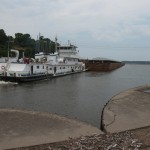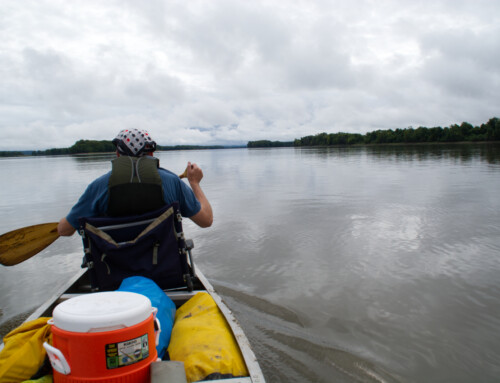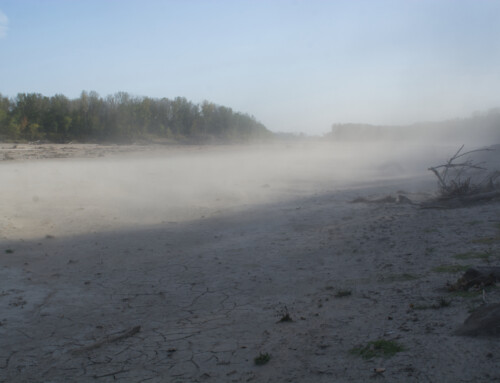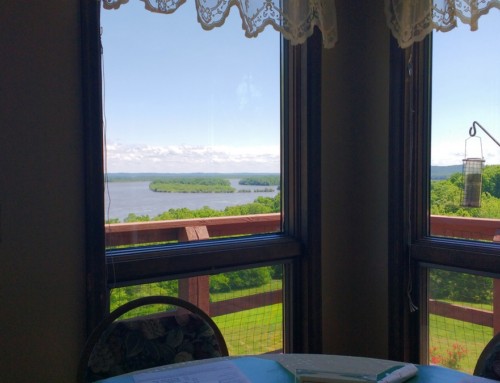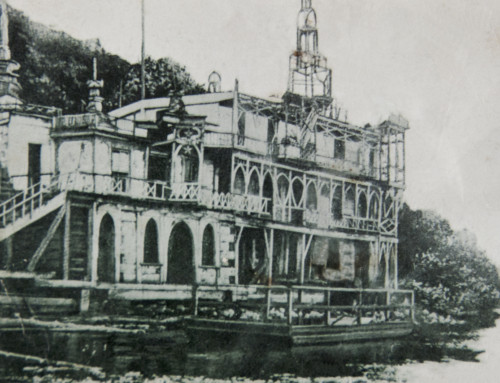The news has been relentless since the fall: the Mississippi River is running out of water—dying, even! —and commercial shipping is in danger of stopping. Food prices will rise! Thousands of jobs will be lost! Life As We Know It will end! Grab your canned corn and head to a cave now!
I’m not sure if I’m bothered more by the persistent cries from shipping interests or the media’s mindless parroting of those howls. Every news account of the drought-induced low water just repeats the doomsday scenarios concocted by industry groups.
In the midst of the hysterical coverage and the concerns about commercial traffic on the river, it’s easy to forget that what’s happening is just part of a natural variation in river levels. The Mississippi River has a capacity for tremendous variations in the water it carries. The lower Mississippi River has been around for millennia, but our formal records barely cover a century. We have observed the river’s cycles for a miniscule amount of time.
While these variations in flow are natural for the river, they cause problems for us because of our efforts to control it for our needs—walling it behind levees to protect our homes and businesses from high water (then building more homes and businesses behind the taller levees) and dredging and damming it to create water deep enough to maintain the river as a superhighway for barges. Every now and then, the Mississippi River reminds us that, in spite of all our efforts to control it, it is still a river that is subject to natural variations and that we should stop whining and panicking every time high or low water inconveniences our economic desires.
The news reports bother me for another reason, though. I’m concerned about what’s missing from the media reports (and the industry press releases): voices besides industry lobbyists, such as river stakeholders who wonder if the costs of managing the Mississippi River for shipping are really worth the return.
We are supposed to be in the midst of a national budget crisis, so this should be a good time to ask a few key questions:
• How much do we spend to maintain a shipping channel on the Mississippi River?
• Who pays for it?
• What has been the cost to the river in terms of environmental damage?
• Ultimately, do all the costs justify the expense?
I don’t have the answers to all these questions right now (I’d be happy to research them if someone would award me a grant to do so) but, here are a few nuggets I’ve pulled together recently that suggest some answers:
What is the cost of maintaining a shipping channel on the Mississippi River?
Calvin Fremling wrote in his 2005 book, Immortal River, that the direct annual cost of building, maintaining, and operating the locks and shipping channel on the Mississippi River was about $647 million.
Who pays for it?
Until 1978, US taxpayers covered the entire cost of maintaining the navigation channel. Since that time, barge operators have paid a diesel fuel tax (initially $0.04/gallon on barge fuel, but $0.20/gallon since 1994). Money from that tax goes into the Inland Waterways Trust Fund, which pays for about half of the cost of new construction on all inland waters (not just the Mississippi River), at least for projects that are projected to cost at least $8 million. The Trust Fund does not pay for routine maintenance and operating costs; US taxpayers cover the full cost of those expenses. In 2011 $84 million was collected for the Inland Waterways Trust Fund. Fremling noted that commercial interests pay about 10% of the direct costs of building, maintaining, and operating the shipping channel on the Mississippi, but that estimate may be optimistic. How does that compare to other industries?
A lot of people point to Amtrak as the poster child of taxpayer handouts, but in 2011 government subsidies accounted for only 15% of its budget.
We have a fuel tax in this country to pay for highway construction and maintenance. Everyone who buys gasoline pays the tax, so, in theory, all users are paying to maintain the system. While the gas tax does not cover the entire cost of highway construction (and hasn’t for a while), it covers at least half of the costs and probably much more, which is a much larger portion than the barge industry pays for its infrastructure.
The gas tax is paid by everyone who buys gasoline and not just commercial trucks, so maybe it’s time to emulate that model and add more user fees to the river navigation system, too. Right now, passing through a lock is free. In the past, the Congressional Budget Office, the Simpson Bowles Commission, and others have recommended increasing user fees on inland waters, either by charging a fee to lock through or by raising the diesel tax to a level high enough to cover the system’s costs, ideas that have been opposed by commercial shipping interests. (As long as canoes lock through for free, it’s fine by me!)
What has been the environmental cost of maintaining a shipping channel?
I offer two examples. Before the lock system was built on the Upper Mississippi River in the 1930s, the river had a braided channel with multiple islands that supported a diverse ecosystem. Since the dams raised water levels, many of those islands have gradually washed away, reducing the ecological diversity of the river (fewer types and numbers of plants, fish, birds, and wildlife).
The Capoli Slough Habitat Rehabilitation and Enhancement Project was funded to reconstruct 49 acres of islands (significantly less than the 74 acres that existed in that spot before the dams were built) by reinforcing the shorelines of existing islands and building a few new ones. This one environmental restoration project has a budget of $10 million. That’s just one project in one small part of the river to restore damage that was caused by our efforts to make the river more shipping friendly. By the way, from what I’ve been able to discern, none of the money in the Inlands Waterways Trust Fund gets allocated for environmental restoration.
At the other end of the river, extensive channelization for shipping and levees for flood protection cause the loss of 16 square miles (10,240 acres) of delta land every year. The loss of land reduces the ecological diversity of the delta region (fewer shrimp and oysters, for example) and eliminates a natural barrier that mitigates the impact of major storms on inland regions like New Orleans and other Gulf Coast communities. In 2012, the Coastal Wetlands Planning, Protection and Restoration Act Task Force approved spending $81.6 million on projects including: $39.3 million to rebuild 484 acres of marsh on the west bank of the Mississippi River in Plaquemines Parish; $29.8 million to rebuild 648 acres of marsh on the east bank in Plaquemines; and $12.5 million for replanting wetland plants like grasses and shrubs. While this is an important step, this project is trying to restore just 11% of the delta land lost in ONE year.
In short, we’ve spent (and continue to spend) an enormous amount of money to make the river more navigable for big boats and those efforts have caused extensive damage to the river’s ecosystem and wildlife, damage that is very expensive to fix.
Industry groups are quick to proclaim the economic impact of shipping on the Mississippi, and those numbers are mindlessly repeated in most news stories. I haven’t yet tried to find an independent analysis of the real economic benefits, but I sure hope one exists. We shouldn’t be relying on groups that are asking for more money to provide reliable data on the value of their product.
In our risk-averse culture, it’s easy to forget that river navigation has always been risky. In the latter half of the 19th century, railroads replaced steamboats in the transportation network. While the railroads were often ruthless in the games they played to hasten the shift, the main reason railroads pushed steamboats aside was predictability: railroads offered it and river transportation didn’t. Water levels in the river varied too much. Sometimes the water was too high for boats to run, sometimes it was too low; sometimes the river was frozen. Railroads, however, ran all the time.
The construction of the lock and dam system in the 1930s by the federal government was meant to make the river more predictable by ensuring sufficient amounts of water were in the shipping channel throughout the year. But the construction of the lock and dam system marked a fundamental shift: we transferred the economic risks of shipping by river from private companies to US taxpayers. And, in spite of those locks and dams, the upper portion of the river still freezes, closing it to all traffic for several months every year.
Maybe this is good policy, but it doesn’t seem so to me. I didn’t study economics in college, and I don’t have an MBA, but it seems to me that any industry that is so dependent on government subsidies to survive probably has a flawed business model. I’m pretty sure that my business would do very well if I could convince the government to cover the costs of printing all my books; I could even create a couple of jobs because of it. I suspect, though, that my proposal would be a hard sell.
I’m not suggesting that shipping be abolished, but I am suggesting that we look more closely at exactly what it is costing us to maintain a shipping channel on the Mississippi River, not just in terms of how much taxpayers subsidize private companies but also in environmental damage. And, when it comes to issues that affect management of the Mississippi River, we should be listening to voices from all stakeholders, not just those connected to commercial shipping.
The problem ultimately isn’t too little water being released from Missouri River reservoirs or not enough dredging or locks that are too small or too old. The problem is simple. The Mississippi River, in spite of our attempts to turn it into the Erie Canal, is still subject to natural forces that can vary tremendously. We can expend huge amounts of money trying to even out those variations or we can find a way to live with them. While it might be possible to engineer our way around these natural forces for a while, I’m not sure we can afford to.
© Dean Klinkenberg, 2013
Community-supported writing
If you like the content at the Mississippi Valley Traveler, please consider showing your support by making a one-time contribution or by subscribing through Patreon. Book sales don’t fully cover my costs, and I don’t have deep corporate pockets bankrolling my work. I’m a freelance writer bringing you stories about life along the Mississippi River. I need your help to keep this going. Every dollar you contribute makes it possible for me to continue sharing stories about America’s Greatest River!
